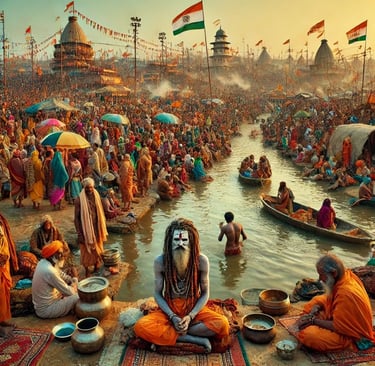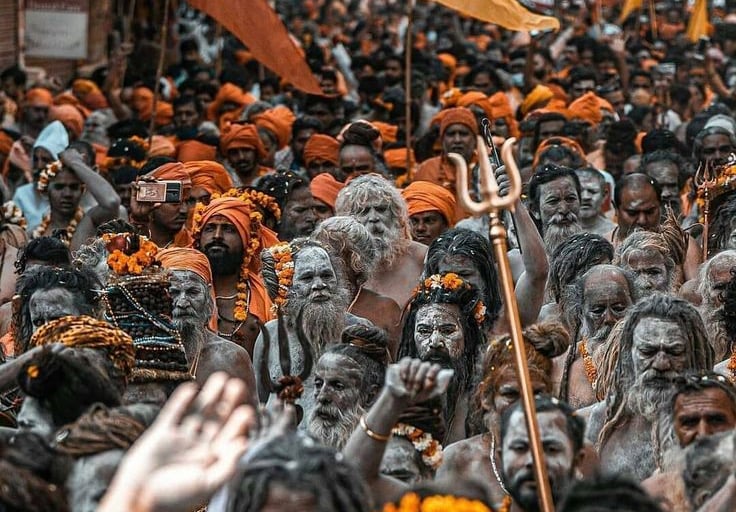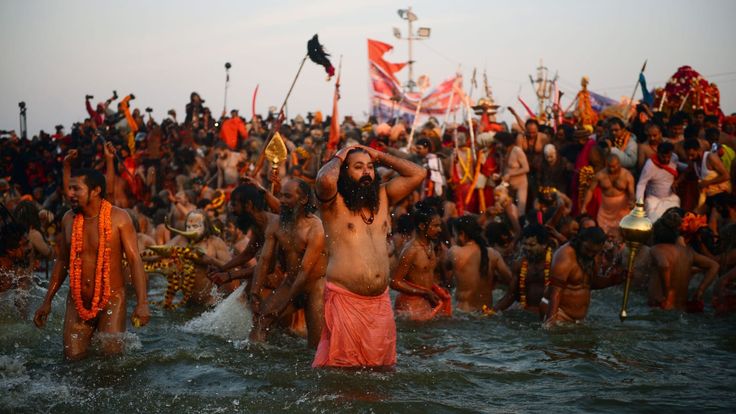Naga Sadhus war- 1757
Ahmad Shah Abdali’s campaign in 1757 was not merely about territorial conquest; it was a targeted religious war against Hindu culture. Abdali's army was infamous for pillaging temples, desecrating idols, and massacring innocent Hindus
HISTORY
1/20/20255 min read


The Forgotten Battle of 1757: When Naga Sadhus Stood Against Ahmad Shah Abdali
The annals of Indian history are filled with tales of valor, resistance, and sacrifice. One such inspiring yet lesser-known event is the Battle of 1757, where the Naga Sadhus, the warrior ascetics of Sanatan Dharma, rose to defend their land and dharma against the Afghan invader Ahmad Shah Abdali. This episode is a testament to the resilience of Sanatan Dharma, proving that it has never been passive in the face of aggression but has fought relentlessly to preserve its ethos and culture.
The Historical Context: Abdali's Motive
Ahmad Shah Abdali, also known as Ahmad Shah Durrani, was one of the most formidable conquerors of the 18th century. His repeated invasions of India were not just motivated by the lure of wealth but also by a calculated strategy to expand Islamic dominance in the region. Abdali's invasion of 1757 was particularly brutal, targeting Hindu temples, sacred sites, and civilians. His goal was to weaken the cultural and religious backbone of the subcontinent — Sanatan Dharma — by destroying its institutions and demoralizing its adherents.
Abdali's plunder of the sacred city of Mathura and his desecration of Vrindavan's temples sent shockwaves across the region. These atrocities were not merely acts of greed but were aimed at erasing the cultural identity of the land. However, what Abdali underestimated was the unyielding spirit of the Naga Sadhus, the warrior monks who had been safeguarding dharma for centuries.
Who Are the Naga Sadhus?
The Naga Sadhus are an integral part of the Akhara system, a monastic order established by Adi Shankaracharya in the 8th century. These ascetics are not only spiritual seekers but also warriors trained in martial arts and weaponry. Their primary duty has always been to protect Sanatan Dharma and its sacred spaces from external threats. By 1757, the Naga Sadhus had already proven their mettle in various battles, acting as the defenders of temples and dharmic traditions.
The Battle of 1757: A Clash of Ideals
As Abdali's forces advanced into the heartland of India, they encountered stiff resistance from various quarters. However, one of the most significant confrontations took place near Gokul, where a large contingent of Naga Sadhus decided to confront the marauding army. The Naga Sadhus, numbering around 5,000, faced Abdali's well-equipped army of over 40,000 soldiers.
Despite being outnumbered and lacking advanced weaponry, the Naga Sadhus displayed unparalleled bravery. Armed with tridents, swords, and spears, these ascetics charged at Abdali's forces with a ferocity that left even seasoned Afghan soldiers stunned. The battle was not merely a physical confrontation but a clash of ideologies — the invader's zeal to destroy versus the defenders' determination to protect their dharma.
The Naga Sadhus inflicted significant losses on Abdali's forces, killing over 3,000 Afghan soldiers. Historical records suggest that the sadhus fought with such determination that Abdali himself was forced to retreat temporarily, regroup, and rethink his strategy. While the Naga Sadhus eventually succumbed to the superior numbers and firepower of Abdali's army, their resistance became a symbol of dharmic resilience.
The Scale of Destruction: Targeting Sanatan Dharma
Ahmad Shah Abdali’s campaign in 1757 was not merely about territorial conquest; it was a targeted religious war against Hindu culture. Abdali's army was infamous for pillaging temples, desecrating idols, and massacring innocent Hindus. Below is a detailed account of his atrocities:
1. Temples Destroyed
Abdali’s forces destroyed more than 300 temples during his invasion in 1757. These temples were centers of faith, culture, and community life for Hindus. Some of the most prominent temples that were desecrated and looted include:
Govind Dev Temple, Vrindavan: This sacred site dedicated to Lord Krishna was plundered and defiled by Abdali's soldiers. Precious idols and offerings were taken, and the temple’s sanctity was violated.
Keshav Dev Temple, Mathura: Mathura, the birthplace of Lord Krishna, faced unparalleled destruction. The Keshav Dev Temple was looted, idols were broken, and the sanctum sanctorum was desecrated.
Kankali Tila Temple: Known for its historical and spiritual significance, this temple in Mathura was also destroyed, leaving behind a trail of ruins.
2. Sacred Sites Desecrated
Abdali’s forces did not spare sacred cities such as Mathura, Vrindavan, and Gokul. These places were centers of devotion for millions of Hindus.
Vrindavan: Abdali’s soldiers carried out a mass slaughter of priests and devotees in Vrindavan. Sacred idols were smashed, and temples were set ablaze.
Mathura: The city witnessed a horrific massacre where thousands of Hindus were killed, and women were abducted and enslaved. Historical records suggest that Mathura’s ghats were soaked with the blood of innocents.
The Massacre of Hindus: Genocide by Abdali
1. Casualties During the Invasion
Historical accounts, such as those by British historians like Mountstuart Elphinstone, estimate that Abdali’s forces massacred approximately 50,000 Hindus in 1757 alone. The victims included priests, pilgrims, farmers, and common citizens who were slaughtered mercilessly.
2. Women and Children Enslaved
Over 20,000 Hindu women and children were abducted and taken as slaves. These women were forcibly converted, raped, and sold in markets in Afghanistan and Persia. Young girls from Mathura and Vrindavan were paraded naked in the streets before being sent off to foreign lands.
3. The Brutality of the Afghan Forces
Abdali’s soldiers were notorious for their barbarity. Villages were burned to the ground, and entire communities were wiped out. In Mathura, thousands of Hindus were burned alive in their homes and temples. The ghats of the Yamuna River turned into slaughter grounds as devotees were butchered.
Economic Loot: The Destruction of India's Wealth
The wealth looted by Abdali during his 1757 invasion is estimated to be worth billions in today’s currency. The treasures of temples, including gold, silver, and precious jewels, were carried away to Afghanistan. Mathura alone yielded immense riches, with Abdali’s forces plundering temple offerings accumulated over centuries. Vrindavan’s idols, made of gold and adorned with jewels, were melted down and transported to Kabul.
The Real Intention Behind Abdali’s Attacks
1. Religious Dominance: Abdali aimed to establish Islamic supremacy in India by targeting the heart of Hindu spirituality — its temples and sacred sites. By destroying these, he sought to demoralize Hindus and weaken their cultural identity.
2. Economic Exploitation: Abdali was driven by greed, using religious fanaticism as a pretext to loot India’s wealth.
3. Strategic Expansion: Abdali’s invasions were part of a larger plan to expand his Durrani Empire and create a buffer state between his empire and the declining Mughal power.
The Aftermath: A Legacy of Resistance
Though the battle resulted in a tactical victory for Abdali, the courage displayed by the Naga Sadhus inspired countless others to rise against tyranny. Their sacrifice galvanized regional forces, culminating in the Marathas' decisive victory over Abdali in the Third Battle of Panipat (1761). The Naga Sadhus' stand also reinforced the idea that Sanatan Dharma is not a passive tradition but one that actively resists aggression to protect its spiritual and cultural heritage.
Sanatan Dharma: A Civilization of Warriors
The Battle of 1757 is a powerful reminder that Sanatan Dharma has never been weak or submissive. From the time of the Mahabharata to the modern era, dharmic forces have repeatedly risen to protect their culture and way of life. The Naga Sadhus exemplify this spirit, showing that even ascetics can become warriors when dharma is under threat.
The narrative that Sanatan Dharma is inherently passive is a distortion. Whether it was the Rajputs defending their kingdoms, the Marathas challenging the Mughal empire, or the Naga Sadhus confronting Abdali, the history of Sanatan Dharma is replete with instances of active resistance. This resilience stems from the core philosophy of dharma, which emphasizes the protection of righteousness at all costs.
Key Takeaways for Modern India
1. Sanatan Dharma Is Resilient: The sacrifices of the Naga Sadhus demonstrate that dharma is not just a set of beliefs but a living force that inspires action.
2. Unity in Diversity: The collective efforts of sadhus, warriors, and common people in resisting Abdali highlight the strength of unity in preserving cultural heritage.
3. Historical Awareness: It is essential for modern Indians to remember and honor such episodes of resistance, as they form the backbone of our civilizational pride.
Conclusion: Remembering the Forgotten Heroes
The 1757 invasion of Ahmad Shah Abdali is not just a story of destruction but also of resistance and sacrifice. It reminds us of the resilience of Sanatan Dharma and the countless sacrifices made to preserve it. As modern Indians, it is our duty to remember these events and honor the legacy of those who fought to protect our cultural heritage.



